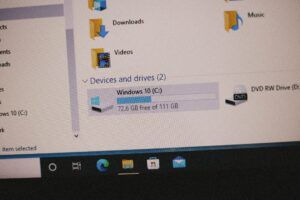How to Create Backups on Windows Like an Expert

How to Create Backups on Windows Like an Expert
Data loss may occur at any moment, and there are a variety of potential causes for it, including inadvertent deletion, hardware failure, malware assaults, and even unanticipated system problems. Developing dependable backups is the most intelligent approach to safeguard your information of great importance. Professionals use a more systematic approach compared to the majority of Windows users, who depend only on the built-in solutions such as copying and pasting files to an external drive. If you want to create backups like a professional, you must have a thorough understanding of the appropriate instruments, techniques, and tactics to guarantee that your information is accessible, safe, and recoverable at all times.
The Importance of Backups
A single incident, such as a hard drive accident or a ransomware assault, has the potential to permanently delete years of data, photographs, or labor projects. Problems with synchronization and account lockouts might occur even while using cloud storage services. You may minimize stress and downtime by using backups as a safety net that enables you to rapidly restore your information and system. Professionals are aware of the fact that data security is not a matter of chance; rather, it is a matter of being prepared.
Gaining an Understanding of the Various Types of Backups
It is critical to have a strong grasp of the primary categories of backups prior to beginning to use tools.
- Full Backup: A full backup of all of the files and folders that have been chosen. Dependable, although it takes a significant amount of time to complete.
- Incremental Backup: This kind of backup only generates copies of files that have been modified since the previous backup was performed. Faster and more efficient in terms of space
- Backup of Differences: Files that have been altered since the most recent complete backup are copied. Maintains a balance between speed and storage capacity
- System Image Backup: Generates an identical clone of your whole Windows system, including all of your applications and settings.
- These two categories are often mixed together by professionals in order to attain both dependability and efficiency.
How to Utilize the File History Feature in Windows
File History is a pre-installed feature in Windows that automatically creates backups of files stored in libraries, on the desktop, in the contacts list, and in the favorites list. To make it possible:
- Navigate to the following location: Settings > Update & Security > Backup.
- Make a selection Include a drive and then choose either a network location or an external drive.
- Activate the automatic backup of my computer’s files.
- This function makes certain that backups are consistently performed without requiring any human effort.
Generating backups of system images
Windows has the option of generating a system image in order to ensure that your computer is completely protected. This image may be used to restore your whole PC in the event that it crashes. In order to construct only one of them:
- Go to the Windows 7 operating system’s Backup and Restore section of the Control Panel.
- Make a selection Make a system picture by using the information in the left panel.
- Decide on a place to store your data. You may choose from a variety of options, including external hard drives, DVDs, or network drives.
- Allow Windows to make the entire backup by beginning the procedure.
- For professionals who are unable to deal with prolonged periods of downtime, having a system image is really necessary.
Making Use of OneDrive for Backups in the Cloud
The cloud backups that are created with Microsoft OneDrive are smooth since the service is directly integrated into Windows. Your papers, photographs, and desktop items will automatically be synced to the cloud when you use it. It is common practice for professionals to activate Known Folder Move, which sends important folders to OneDrive. This ensures that data stays secure even in the event that the computer is lost or destroyed.
Solutions for backing up data from other parties
Although built-in tools are beneficial, professionals often depend on third-party software that is more sophisticated in order to get more control over their work. Some of the most common choices are:
- Macrium Reflect: Excellent for disk imaging and scheduled backups.
- Acronis Cyber Protect: Provides both cloud-based and local backups in addition to offering security measures.
- EaseUS Todo Backup: This software has a user-friendly interface and provides a variety of adaptable backup solutions.
- Veeam Agent for Windows: Enterprise-level dependability for usage in both residential and commercial settings
- The encryption, compression, and scheduling capabilities that are provided by these tools surpass those that are offered by default in Windows.
Automating the Routine for Backing Up Your Data
The fundamental characteristic of excellent backup management is automation. Schedule backups to run either on a daily or weekly basis, rather than performing them manually. Because they are fast and do not take up an excessive amount of storage space, incremental backups are the best option for regular automation.
Selecting the Appropriate Location for Backups
The manner in which you go about creating your backups is just as important as the location where you keep them. The 3-2-1 rule of backup is followed by professionals in the field:
- Three copies of your information (the original plus two backups)
- Two various types of storage media, which include a network attached storage (NAS), an external drive, and cloud storage
- One copy that is kept at a place that is not on-site (either in the cloud or at a distant location).
- This guarantees that protection will be provided even in the case of a fire, theft, or hardware failure.
Checking to Make Sure Backups Are in Good Condition
In the event that a backup is not able to be restored, it is of no value. Professionals routinely do trial restorations in order to evaluate the effectiveness of their backups. This step makes sure that the backup files are not damaged and that they can really restore data when it is necessary.
Securing Backups Through the Use of Encryption
It is imperative that sensitive information be never left without protection. You may assure that your information will not be accessible to unauthorized individuals even in the event that your external drive or cloud account is hacked by encrypting your backups. There are a lot of backup programs available, and Windows itself provides choices for encryption.
Protecting Backup Drives
When you are using external drives, you should consider them to be valuable assets. Keep them in a place that is dry, secure, and protected from harm. Because attached disks are susceptible to ransomware assaults, you should refrain from keeping them linked to your computer indefinitely.
Preparing for Disaster Recovery
Backing up information in a professional manner is not only about preserving the contents themselves; it is also about planning for the possibility of the most worst situation. Having entire system images as well as copies of individual files ensures that you have flexibility, as it allows for both rapid recovery of documents and comprehensive restoration in the event that the operating system fails.
Revising Your Backup Strategy
Your backup strategy should evolve in accordance with improvements in technology. Every few months, you should go back and reevaluate your plan. Examine the amount of storage space that is accessible, and if it is necessary, make the switch to drives that are more dependable. In addition, make adjustments to the schedule in accordance with any new work habits or file sizes that may have been acquired.
If you want to make backups in Windows like a professional, you need to anticipate potential problems and plan for every conceivable situation. You may put up a multi-layered security system that guarantees that your data will remain protected at all times. This security system will be comprised of cloud storage, third-party software, and built-in utilities. Professionals do not wait until calamity hits; they plan in advance, recognizing that data security is the basis of digital productivity and peace of mind.




